Sintra, located close to Lisbon on the western coast of Portugal, is known for its fairytale palaces and castles. The historic cultural landscape of Sintra has been a UNESCO World Heritage site since the year 1995.
Many majestic palaces lie on the slopes of the forested Sintra Mountains, including the colorful Palace of Pena, the mystical Quinta da Regaleira and the less-known Palace of Monserrate with their enormous gardens. There are many exciting things to do in Sintra, such as getting to know the picturesque old town of Sintra and the fabulous buildings surrounding it, such as the Moorish Castle and the National Palace of Sintra. These, together with many other interesting sights centralized on a rather small area, make Sintra one of the most popular travel destinations of Portugal.
The hiking trails of the Sintra-Cascais Natural Park, the beautiful waterfalls and the rugged Atlantic coast with its beautiful beaches offer things to do in Sintra for those enjoying nature and beach life. Sintra is a magical travel destination that makes fairytales come true and that has a breathtaking view opening up behind every corner.
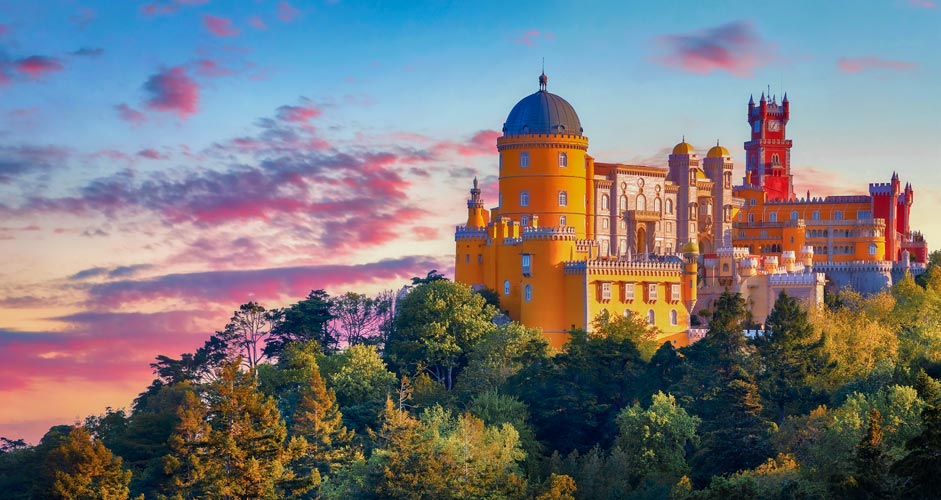
Where to stay in Sintra – elegant villas and cozy farmhouses
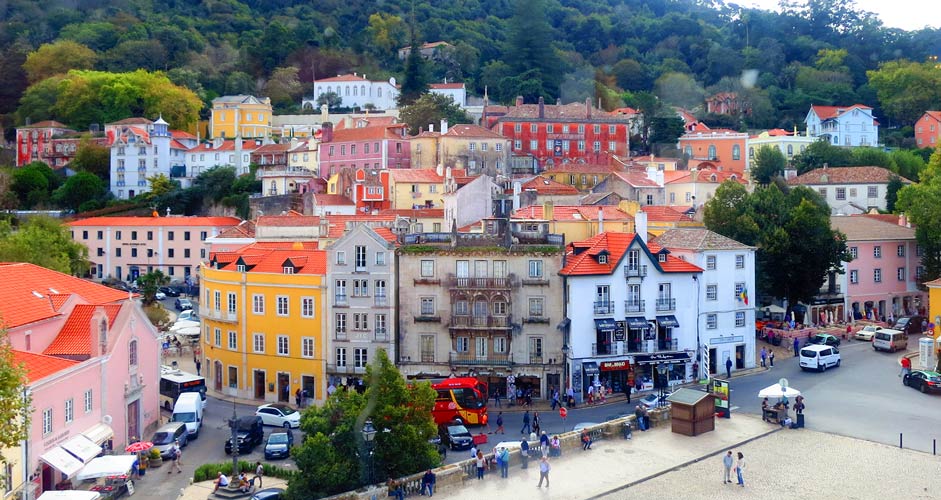
The most central accommodation options in Sintra can be found in the old town center and its surroundings. Sintra is a great place to stay in beautiful old villas and palaces in the glorious style of the past days, which makes one feel almost like a noble person, too. In Sintra and the surroundings there are many gorgeous b&b style farmhouses where to stay with style. If one wishes to stay closer to the beaches, the coastal villages are a good choice.
Many opt for only a day trip to Sintra from Lisbon, but the numerous sights and beautiful nature destinations offer things to do in Sintra for an extended period of time, so spending several nights in Sintra is not exaggerated at all. During one day it’s possible to visit only two or three palaces of Sintra, which should be kept in mind when planning the vacation. On a day trip there is time to discover only a tiny part of the secrets of this intriguing town.
Things to do in Sintra – fabulous palaces and magical gardens
Sintra is a dream destination for those interested in history and enchanting palaces, with different places to explore and unbelievable stories to be heard for days. There are also a lot of amazing gardens and many other points of interest for those that are not so keen on history.
Things to do in Sintra-Cascais Natural Park include getting to know some pretty natural monuments, hiking and spending a day by the beach. The hiking trails of the Sintra Mountains may not be well marked, so a guided hike is advisable. The markings of the coastal trails are better maintained.
If looking to visit several palaces, the entrance tickets can add up to a hefty sum per visitor. However, the money as a whole is spent on the maintenance and repair of these historical buildings by the not-for-profit state company Parques de Sintra-Monte da Lua, S.A.
The Palace of Pena
The incredible fairytale castle of the Palace of Pena looms on top of the Sintra Mountains in its candy colors, being probably the most popular of all the places and things to do in Sintra. Besides the palace itself, there is a lot to see in the magical garden surrounding the buildings.
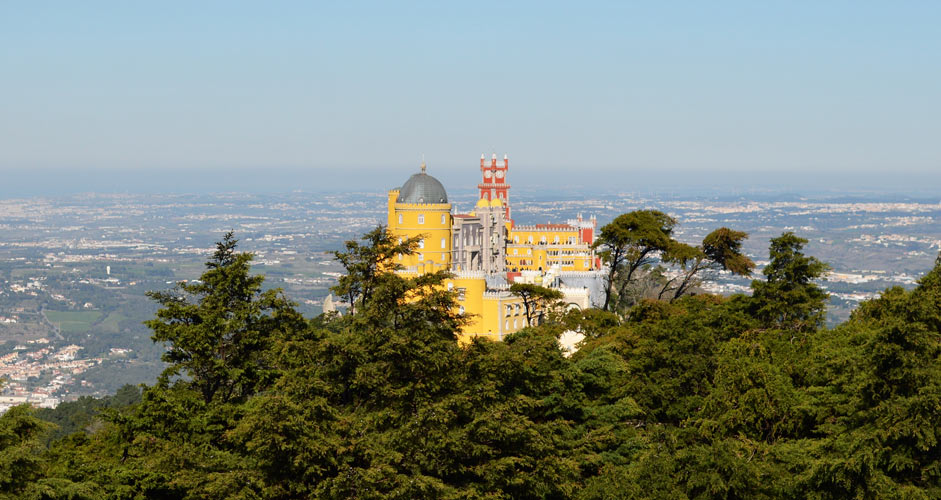
On the place of the Palace of Pena there has been a hermitage and a convent, but the story of the present-day palace starts in the middle of the 19th century, when King Ferdinand II built the current fairytale castle to serve as a summer residence of the royal family. The king designed the details of the romantic palace together with his wife, Queen Maria II. The architecture of the palace is a mixture of different styles, combining the sculptural details to mythical statues and hedonistic splashes of color, not to mention the gorgeous vistas opening up from the palace balconies. The decoration of the palace interior has been restored in the style from the 1910 era, when the last Queen of Portugal, Amélia, left for exile after spending the last night in her home country in the Pena Palace.
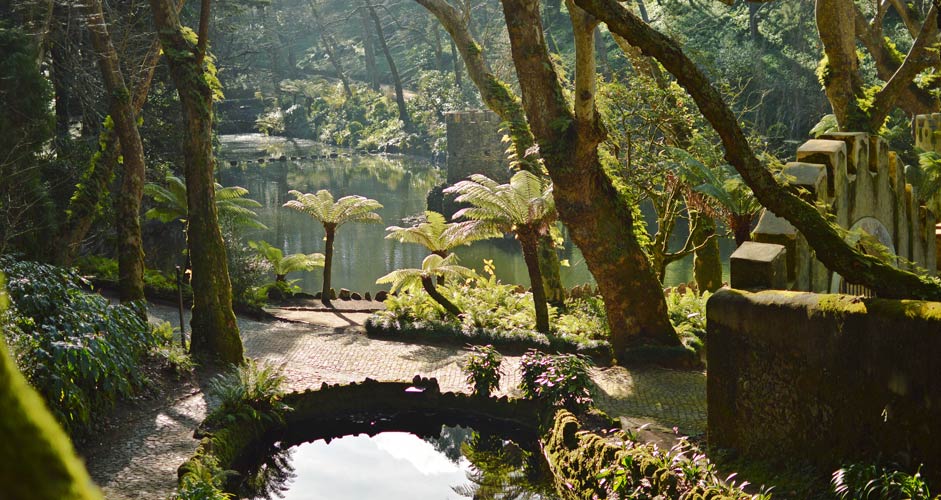
The forested garden of the Palace of Pena spreads on the slopes of the Sintra Mountains in all its 200-hectare glory. King Ferdinand II ordered exotic trees from faraway places such as China and Australia for his garden. The shaded garden hides both fern and rose gardens and the magical Valley of Lakes, between which there is a network of bigger and smaller pathways. The provided map becomes handy in here. One can climb up to the highest place of not only the garden but also the whole Sintra Mountain Chain, the Cruz Alta, with its gorgeous views to the colorful palace visible below and its surroundings. Another one of the highlights of the garden is the Gruta do Monge cave and the Queen’s Throne situated there.
The Palace of Pena can be accessed by hopping on the Circuito do Pena bus line 434 from the Sintra railway station and the town center. From the palace gate there is a shuttle bus service to right in front of the palace, but the hill can also be climbed by foot. There are different ticket options for visiting only the garden or also the interior of the palace. The garden ticket allows admiring the fairytale castle from outside but right next to it.
Exploring the Palace of Pena and its gardens should be allowed at least a few hours, but the place offers enough to see even for almost the whole day. There is a restaurant and a cafeteria on the palace premises.
Chalet of the Countess of Edla
The gingerbread cottage called the Chalet of the Countess of Edla hides in the garden of the Palace of Pena. The villa is a piece of art in its own right, and straight from the pages of a storybook with its romantic tales.
After Queen Maria II died, King Ferdinand II married a Swiss-American opera singer Elise Hensler, who received the title of the Countess of Edla. The countess built a Swiss-style, decorative cottage surrounded by its own garden on the premises of the Palace of Pena. The villa was designed by her and resembles an Alpine chalet. The wooden building was destroyed in a fire in 1999 and was reopened to public after restoration in 2011.
The chalet can be visited with the garden ticket of the Palace of Pena.
Quinta da Regaleira
The magical estate of Quinta da Regaleira is one of the most intriguing non-royal things to do in Sintra. The property includes a romantic palatial villa with its princess chapels, as well as the mystical garden surrounding it. The garden is the definite highlight of the visit, outshining the palace building.
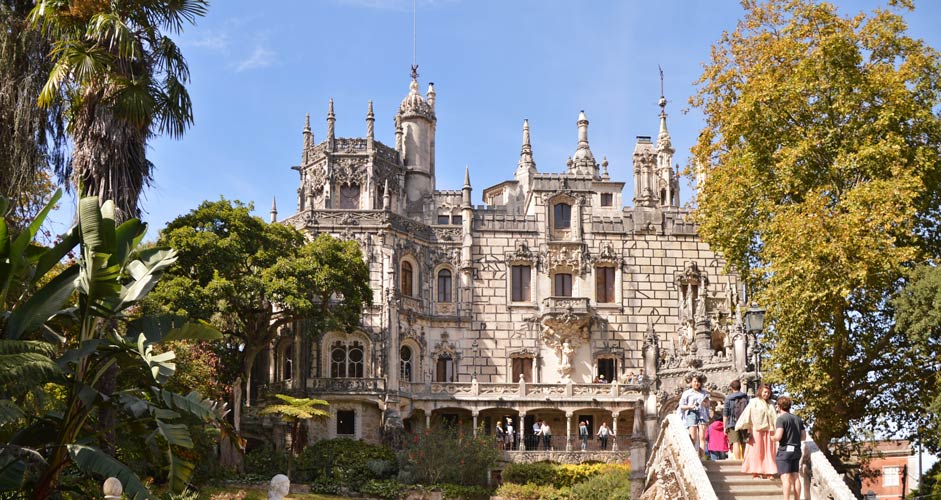
The business man and millionaire António Augusto Carvalho Monteiro bought the 4-hectare estate from the Regaleira count family in order to build there a palace and garden full of symbolic meanings. The detailed palace combining gothic, Manueline and several other architectural styles is designed by the Italian architect Luigi Manini and was finished in 1910. The estate was in private ownership until the year 1997, when it was acquired by the city of Sintra.
Carvalho Monteiro was interested in different ideologies and therefore Quinta da Regaleira is full of different symbols and buildings pointing towards mystics, freemasonry, Rosicrucianism and other occultic movements, but also to literature. The best known is the initiation well, resembling an upside down tower, which has most probably been a place for different rituals.
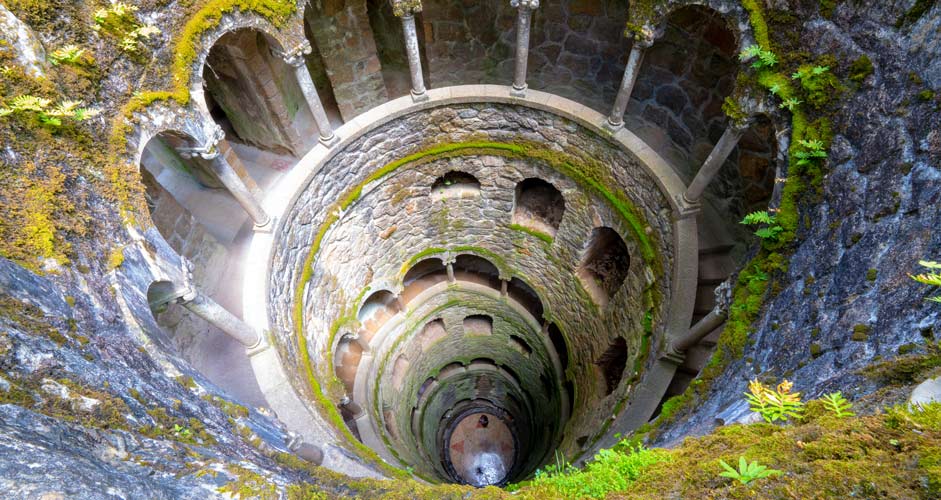
The fabulous garden has been designed to represent a microcosm, starting from an underground level inspired by Dante, continuing through a paradise-like garden all the way to the heavenly plaza of Terraço dos Mundos Celestes. The naturalistic plantations of the forested garden are very organized next to the palace, but purposefully grow wilder when continuing upwards on the hills. In the garden there are several beautiful ponds, caves, grottoes and fountains as well as decorative benches, statues and other buildings by the walking paths. The underground tunnels form a labyrinth through which one can access the chapel and the bottom of the initiation well.
Quinta da Regaleira is situated a few hundred meters outside of the old town of Sintra, so it can be reached by walking on the road. At least two to three hours should be reserved for exploring the estate. Quinta da Regaleira has a cafeteria on the premises.
The National Palace of Sintra
Visiting the National Palace of Sintra is one of the most unique things to do in Sintra, because it’s the only Portuguese royal palace that has remained almost intact from the medieval times until today. The National Palace is also an important part of the cultural landscape of Sintra. The whitewashed palace is located in the old town center of Sintra and easily distinguished by its two huge cone-shaped chimneys of the royal kitchen. The chimneys have become symbols for not only the palace but also the whole city of Sintra.
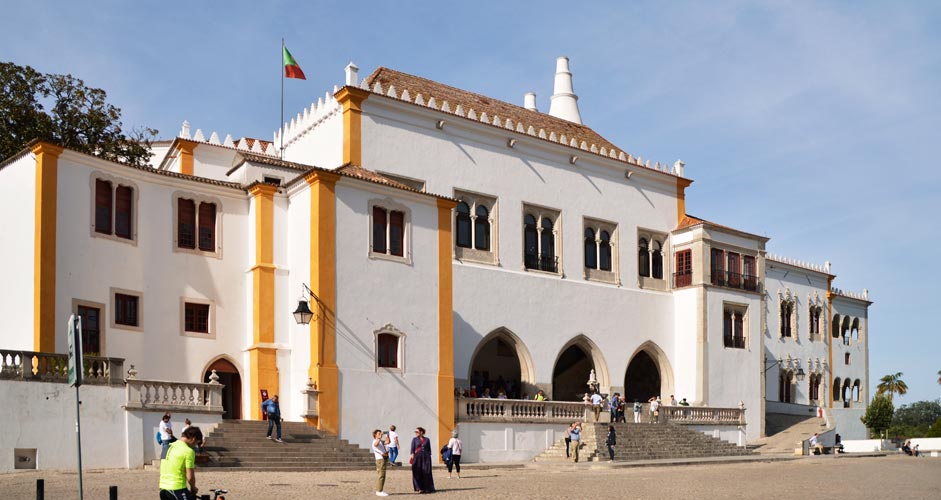
The National Palace of Sintra was originally a habitation of the Islamic rulers of Al-Andalusi, however there are no original structures that would remain visible in the palace. The rebuilding of the current palace started after the Christians re-established power, lead by King Dinis I in the end of the 13th century. The oldest visible part of the building is the palace chapel, but most of the current palace has been built in the 15th and 16th centuries. Since then, the palace served as the summer residence of the Portuguese royal family.
In the 17th century the palace saw some pretty sad times when it served as a prison for the Portuguese King Afonso VI, after the coup by his brother Pedro II. The palace is also the setting for many more stories from the lives of the royal family.
The architecture of the palace is a mixture between several styles, including gothic and Manueline as well as Arabic and Mudéjar styles. Many ceilings have been decorated in the Arabic style with colorful geometric patterns and beautiful paintings, with the gorgeous azulejo tiles garnishing the walls. The National Palace, filled with historical art, has probably the most prestigious interior of all the palaces of Sintra.
Compared to other palaces of Sintra, the National Palace is a castle museum in a more traditional sense, and visiting it should be dedicated at least two hours. The location in the middle of the old town enables an easy access to the palace. One of the palace patios hosts a café.
Castle of the Moors
On top of a hill, above the old town of Sintra, lie the solid walls of the Moorish Castle fortress with its watchtowers. The medieval stronghold was built in order to defense the surrounding agricultural areas during the occupation of the Moors in the 8th and 9th centuries. In 1147 the castle surrendered to Christian conquerors.
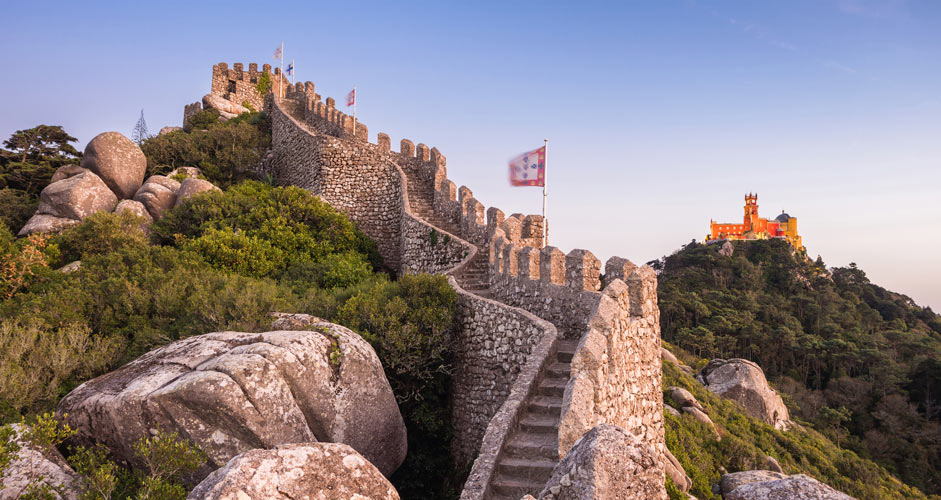
From on top of the winding walls of the Castle of the Moors, there are amazing vistas over the Sintra region. When visiting the castle, it’s easy to imagine the medieval atmosphere of the knight era. The silos dug among the stones and used for storing grain are still visible around the fortress. Archeological studies have also been performed in the area.
The Moorish Castle can be accessed from the railway station of Sintra or from the town centre by the circular bus line 434. There is a cafeteria at the castle.
Monserrate Palace
The Park and Palace of Monserrate is located further away from the town center of Sintra than the other palaces, surrounded by foggy forests of the Serra de Sintra mountains. It is one of the less-known things to do in Sintra, but a definite must.
The exotic and ornamental palace of Monserrate was built by the English Vice Count of Monserrate, Sir Francis Cook, as his summer residence in 1858. The architect was James Knowles Junior who designed the palace to be built on top of the ruins of an old neo-gothic palace. The palace garden already existed at that time. Deserted in the 1920’s, the Monserrate Palace remained for sale over decades, ending up in the possession of the Portuguese state in 1949. For years, people were trying to come up with use for the decaying palace, but the restoration only started in 2007.
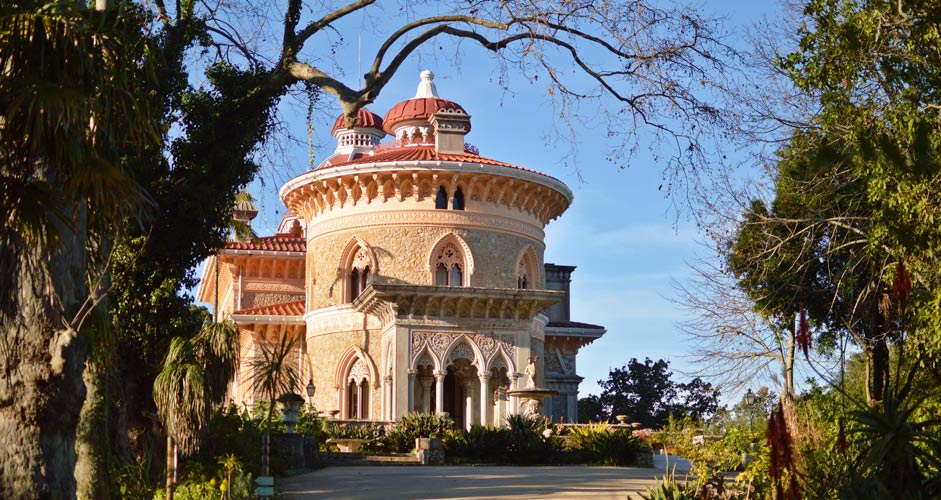
The Palace of Monserrate represents the Portuguese romanticism and it’s perceived as one of the most gorgeous examples of the country both architecturally and landscape-wise. The building has been influenced by gothic, Arabic and Indian architectural styles. The eclectic and exotic building is unbelievably beautiful, like built of lace both inside and outside.
The Monserrate Palace is surrounded by a mystical, layered garden featuring fountains, grottoes, giant trees and ponds lined by palm trees. The garden has separate areas for both Japanese and Mexican gardens, but also a fern valley and rose garden. The garden is also hiding a faux ruin of a chapel and a waterfall.
The Monserrate Palace is located some 4 kilometers west from the old town of Sintra. It can be reached by the bus number 345 from the town center and the railway station of Sintra. At least two hours should be reserved for exploring the palace and its garden. The palace also has a small café.
Convent of the Capuchos
In the middle of the Sintra Mountains lies a mystical medieval monastery called Convent of the Capuchos, Convento de Santa Cruz da Serra da Sintra by its official name. This moss-covered Franciscan convent has been built among high boulders in the middle of untouched oak forests. It is a more down-to-earth destination, offering balance for the splendid palaces and other things to do in Sintra.
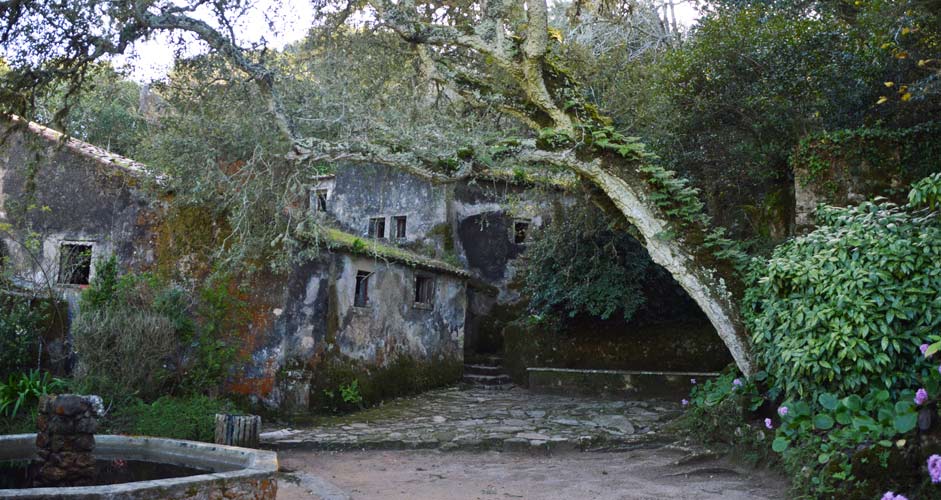
The convent was founded in 1560 by Álvaro de Castro. His father, the Vice King of India, D. João de Castro, had gotten lost while hunting in the mountain forests of Sintra and fallen asleep next to a large rock. There he saw a vision that convinced his son to establish a convent in that exact place.
A small and poor community of Capuchin monks lived in the convent from the middle ages until the 19th century, until the religious orders were banned in Portugal and the convent fell silent. The state of Portugal bought the monastery in 1949, after which the restoration started. In the 1990’s the convent suffered burglaries, being reopened for the public in 2001.
The humble buildings of the convent use boulders as their walls and blend perfectly into the landscape. Even the main chapel of the convent is not distinguishable from the outside. The ascetic spaces and narrow stone corridors with their cork insulation, crosses crafted with sea shells and moss-covered details tell stories about the modest convent life devoted to god. The highest point of the monastery is the cave of Honório de Santa Maria.
Convent of the Capuchos is located in the northwestern part of the Sintra Mountains and only accessible by taxi or a rental vehicle. Next to the convent there is also a donkey sanctuary, where children can ride the donkeys.
Peninha Sanctuary
The Sanctuary of Peninha stands on a rocky and windy hill at an altitude of 448 meters in the western end of the Sintra Mountains. The sanctuary has gorgeous views over the whole coast of Sintra and an intriguing history, but is not among the best known things to do in Sintra. The site consists of several buildings, including a chapel from 1710, an unfinished palace from the early 20th century and a medieval hermitage.
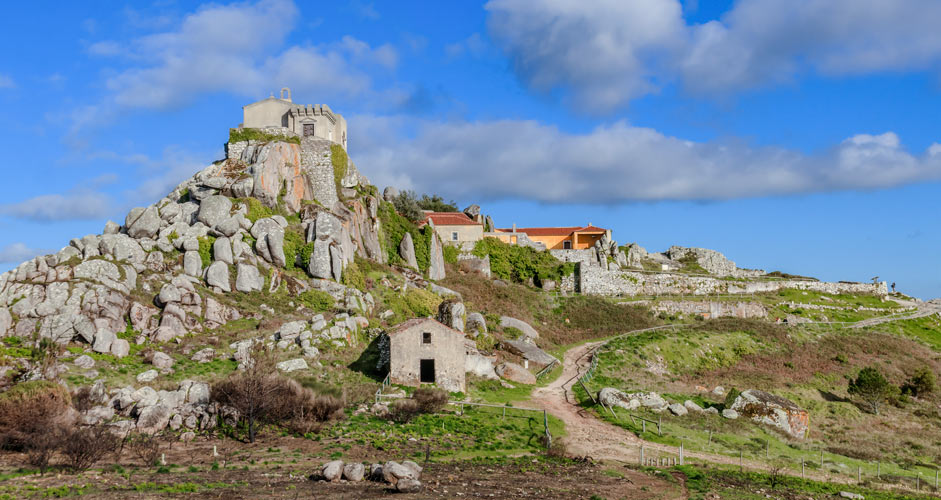
There has been religious activity in the area of Peninha since the arrival of Christianity in Portugal, and the necropolis found at the site has been dated back to the 12th century. The baroque-style chapel was built after a young shepherdess received a vision of the Virgin Mary after losing her sheep in Peninha. The place has also been a popular pilgrimage destination especially among the families of sailors.
António Augusto Carvalho Monteiro, the businessman who also built Quinta da Regaleira, wanted to build a smaller version of the Palace of Pena in Peninha, but passed away before his romantic villa was finished. The unfinished and abandoned building was acquired by the University of Coimbra, and in 1991 by the Portuguese state. The state company Parques de Sintra-Monte da Lua managing the cultural heritage of Sintra has promised to restore the place in the future.
The interiors of the buildings of Peninha cannot be visited at the moment, but the place is nevertheless an interesting destination because of its gorgeous views. Peninha is accessible by taxi or a rental vehicle. No admission fee.
Seteais Palace
The palace of Seteais is a neoclassical palace, built at the end of the 18th century as a residence of a Dutch consul Daniel Gildemeester on the open fields of Seteais. The palace was enlarged in 1802-1803 by the architect José da Costa e Silva, and the Gildemeester residence formed one of the wings in the symmetrical palace. The wings are joined together by a decorative triumphal arch. The palace was obtained by the state of Portugal in 1946.
The Seteais Palace is nowadays a luxurious five star hotel, equipped with a restaurant and a spa. The palace is surrounded by several lawns and elegantly constructed gardens. It has a view opening up to the Castle of the Moors.
The Palace of Seteais is located next to Quinta da Regaleira, approximately 700 meters from the old town of Sintra.
Vila Sassetti
The Mediterranean Villa Sassetti was built in the 1890’s as a summer residence of a local hotel owner Victor Carlos Sassetti. The gorgeous building with its round towers and combination of different shades of terracotta has gotten its inspiration from the castles of Lombardia. Designed by the architect Luigi Manini, the romantic villa fits harmoniously in the surrounding lush garden.
Vila Sassetti is located in direct proximity to the old town of Sintra and there is no entrance fee. The villa is located at the start of a trail leading to the Palace of Pena through the steep, forested hills. On the trail it’s possible to spot rock climbers in action. If possible, it’s advisable to walk this trail downhill, starting from the Palace of Pena. The PR4 route through Azinhaga do Vale dos Anjos is a gentler option for climbing up.
Things to do in Sintra – Nature destinations
Cabo da Roca
Cabo da Roca is located on the coast of Sintra and forms the westernmost point of the Sintra Mountains, of Portugal and also of the whole continental Europe. The cape is located on 140-meter high cliffs and provides rugged vistas over the Atlantic Ocean. Cabo da Roca also has a working lighthouse. The coast surrounding this remarkable cape is beautiful, and there are many hiking trails in the area.
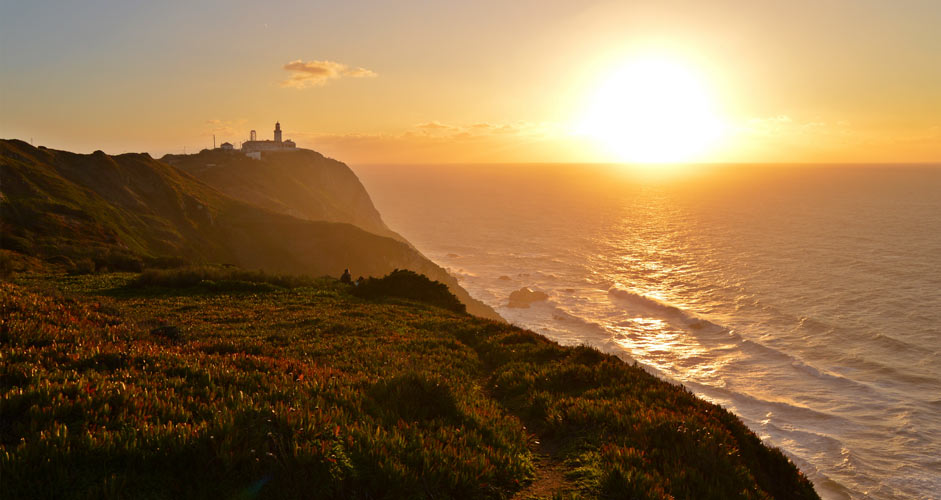
It’s mandatory to keep a safe distance to the edges of the cliffs. One can get to Cabo da Roca from Sintra and Cascais by the ScottUrb bus number 403. The bus leaves from the railway station of Sintra.
Waterfalls
Things to do in Sintra include visiting the several beautiful waterfalls of the area, which can be visited with some planning. The Cascata de Anços, also known as Cascata do Mourão, is the largest of the many waterfalls that can be found on the Rio Mourão river. The place is idyllic for admiring nature, listening to the roar of the water and swimming below the waterfall. The waterfalls can be found just outside the Anços village, at the end of a short hiking trail. There is a signpost at the center of the village, on Rua da Laranjeira street.
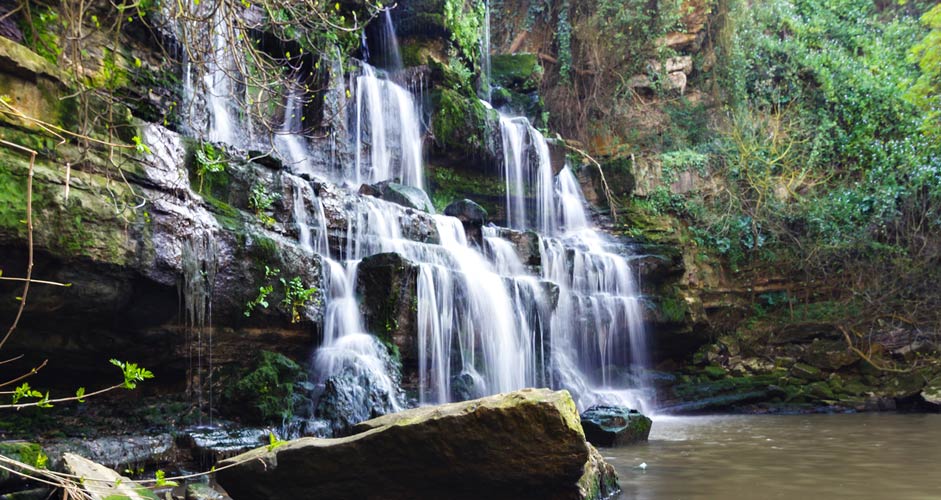
The Cascata de Fervença doesn’t have as paradise-like environment as Cascata de Anços, but the waterfall itself is even more beautiful. It’s also known by the name Cascata da Bajouca. The waterfall is situated in the village of Fervença, at the end of the Rua da Bajouca road.
Lagoa Azul
The forests of the Sintra Mountains conceal a peaceful lake called Lagoa Azul. The place is nice for a picnic and walking on the paths surrounding the lake. The lake is also a home to ducks, tortoises and many fishes. Swimming is not advisable due to the water quality. Lagoa Azul is located by the N9-1 road.
The Geo-Monument of Granja dos Serrões
The Sintra-Cascais Natural Park offers many things to do in Sintra, also hiding the Cretaceous limestone formations of the geological monument of Granja dos Serrões. When following the trail through the lush forest, one is encountered with rough karst boulders, each one even more oddly shaped than the other. The acid rain water has over time eroded the limestones into nature’s own sculptures. The trail can be found by the Avenida do Lapiás road.
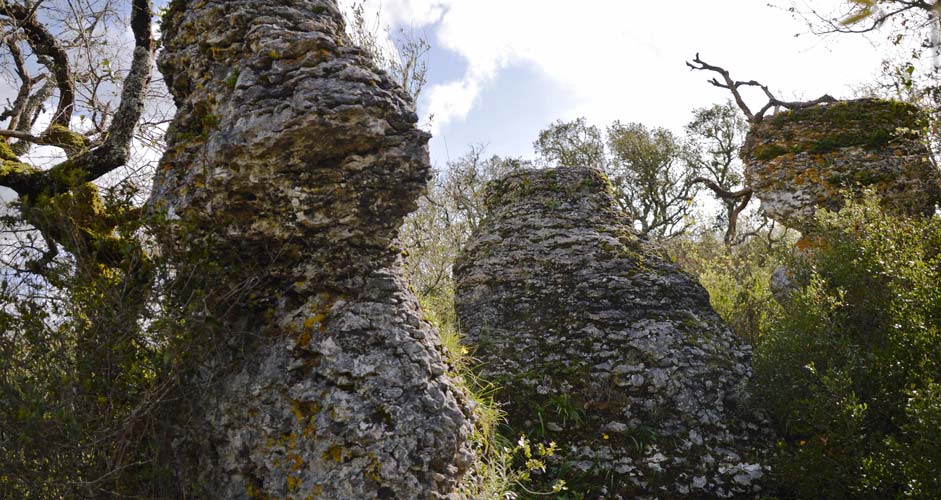
Beaches in Sintra
Things to do in Sintra include relaxing by the beach as well, because the long coast of the city has many gorgeous stretches of sand for spending a leisurely beach day or admiring the sunset by the ocean. Some beaches can be reached by public transport from the center of Sintra, but since the buses may not always run often, a taxi or a rental vehicle is a more flexible means of transport. However, it may be challenging to find parking spots during the summer season.
Praia da Ursa
The iconic beach of Praia da Ursa is located right next to the most western point of Europe, Cabo da Roca. It’s possible to hike down to this gorgeous beach. The trail is steep, but the views with the rock formations are absolutely breathtaking. Cabo da Roca can be reached from Sintra and Cascais by the ScottUrb bus number 403. The bus departs from the railway station of Sintra.
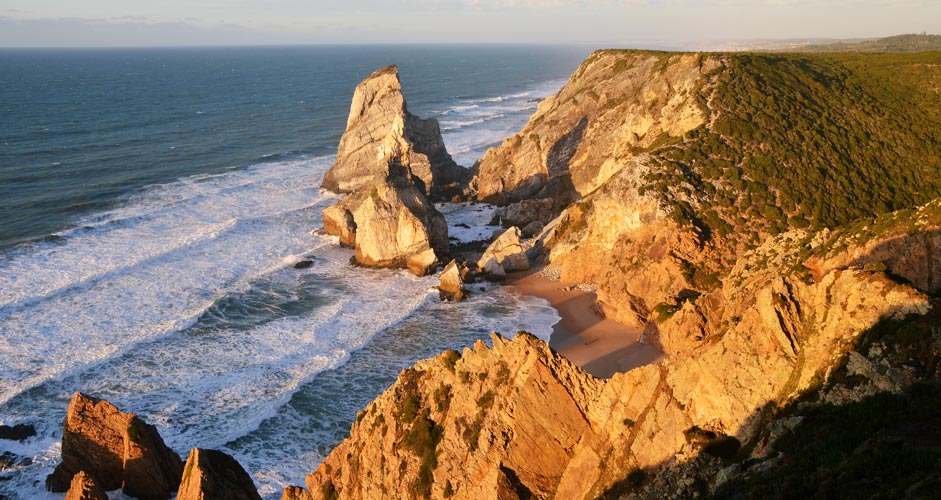
Praia da Adraga
Praia da Adraga is a beautiful beach in its natural state, surrounded by rugged coastal rock cliffs. The caves formed in the cliffs and the rocks rising from the ocean make the silhouette of this beach dramatic. The beach has a restaurant and toilets, but no public transport connections.
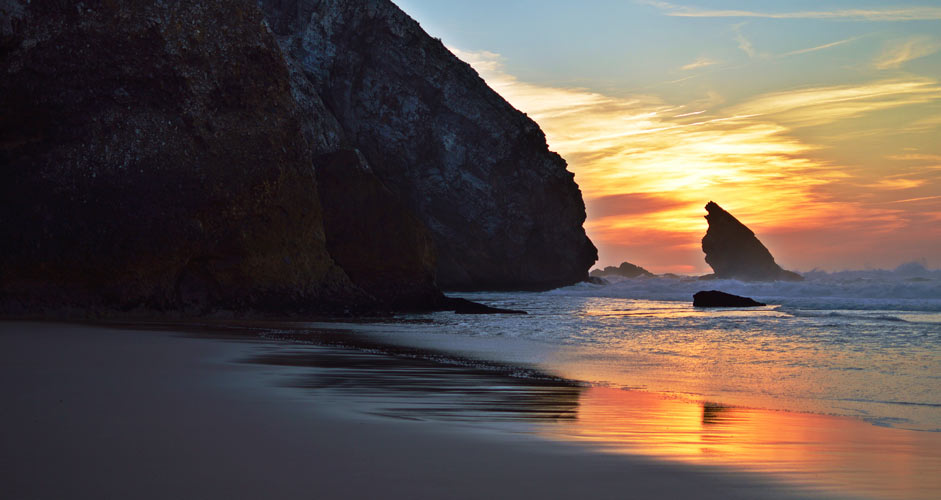
Praia das Maçãs
During summertime, the historical tram takes passengers from the center of Sintra to the Praia das Maçãs beach through gorgeous views. The destination is a sandy beach formed by a stream, surrounded by a handful of restaurants. There is also an open-air swimming pool and an archeological sight called Alto da Vigia. One can get to the Praia das Maçãs from Sintra also by hopping on the ScottUrb bus number 441. The bus leaves from the Portela de Sintra station.
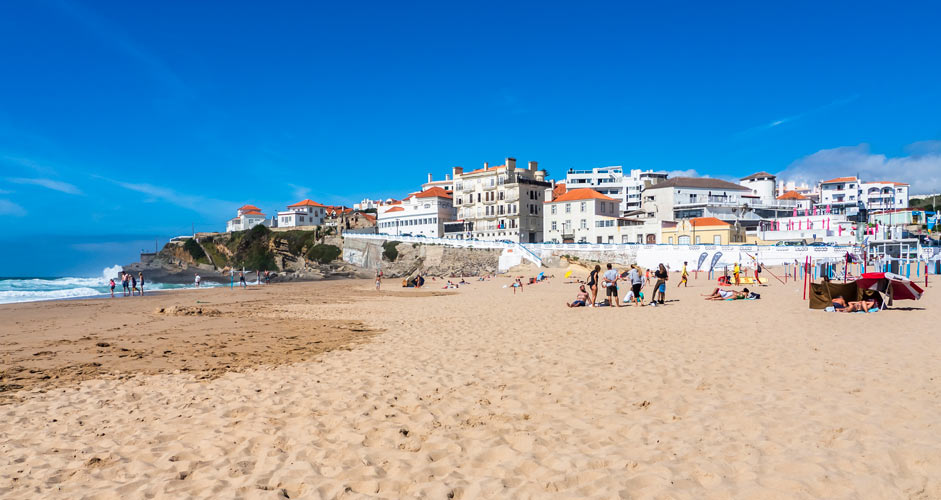
Praia Grande
The same historical tram stops also close to Praia Grande, which is true to its name as the largest beach of Sintra. The beach is popular especially among surfers and bodyboarders and lined by many bars and restaurants. On the high cliffs of the southern end of the beach, there are fossils of dinosaur footprints that can be observed freely. Praia Grande also has a 100-meter long sea water pool, which belongs to the Arribas Hotel. The beach can be reached from Sintra by the ScottUrb buses number 441 and 439, departing from the Portela de Sintra station.
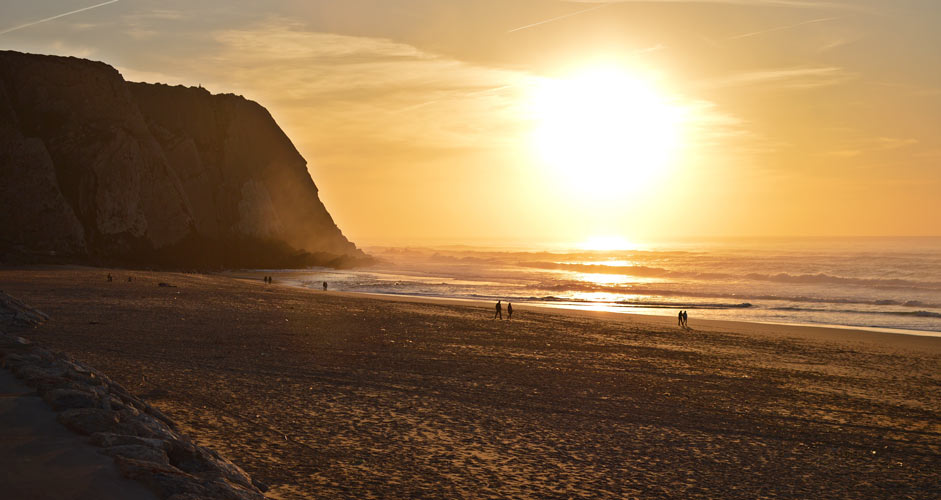
Azenhas do Mar
Azenhas do Mar is probably the most photographed village on the coast of Sintra. The whitewashed houses with their red-tiled roofs of this picturesque village climb on the steep cliffs directly from the ocean. Below the village there is a sandy beach and a sea water pool. The historical village has been named after the multiple traditional water mills that stood on the place. One can get from Sintra to Azenhas do Mar by the ScottUrb buses number 440 and 441, which depart from the Portela de Sintra station.
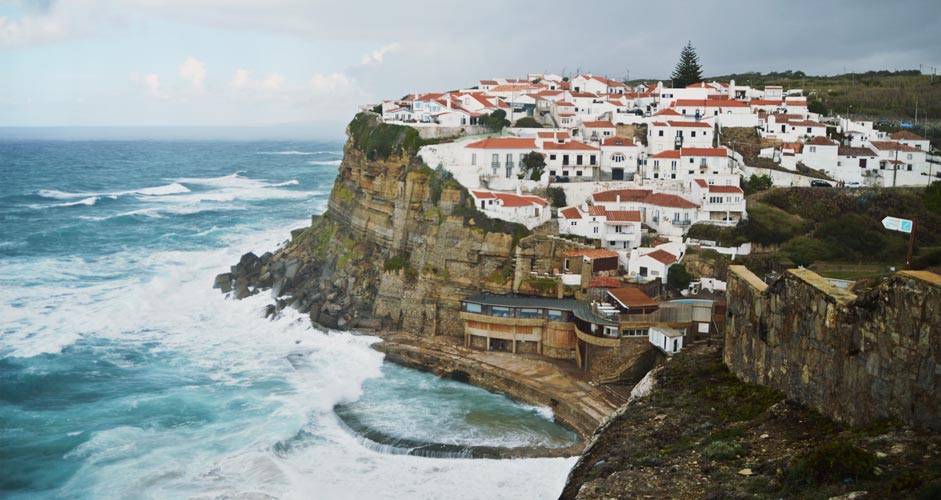
Praia da Aguda / Praia do Magoito
Praia da Aguda and Praia do Magoito are the two ends of the same long and wide stretch of sand. The windy beach is lined by rugged coastal cliffs that feature ancient sand dunes fossilized into sand stone. The views are gorgeous, but the beach is often batted by high waves that can be dangerous for swimmers. The beach can be accessed by foot via steep staircases.

On the Good Friday, hundreds of people gather on the beach to collect clams. Praia do Magoito can be reached from Sintra by the ScottUrb bus number 444, departing from the Portela de Sintra station.
Praia da Samarra
Praia da Samarra is a sandy beach formed in a deep cove in between the coastal rocks. It has a shape deeper than its length, and the beach was supposedly acting as a natural port during the Roman Empire. The beach is small but beautiful and quiet. There are no facilities or public transport connections.
Food and restaurants – What to eat in Sintra
The old town of Sintra has a selection of restaurants and cafés serving Portuguese and international food. Many of the palaces of Sintra are located further away from the restaurants of the city center, which makes returning there for lunch unpractical. Therefore, packing a picnic lunch may be a good idea. Some of the palaces have cafeterias serving meals, salads and bakery products.
The best things to do in Sintra include tasting the queijadas de Sintra cheese pastries. Another local treat are the travesseiros rolls filled with egg custard and almonds. The Piriquita bakeries have been in the reputation of the most authentic café of Sintra for over 160 years.
When visiting the coastal villages, trying some fresh fish and seafood is a must.

Shopping in Sintra
In the old town of Sintra there are many small boutiques selling souvenirs and handmade local products. There is a larger supermarket close to the Portela de Sintra railway station. Sintra also has a shopping mall called Alegro Sintra, but it’s located several kilometers away from the old town.
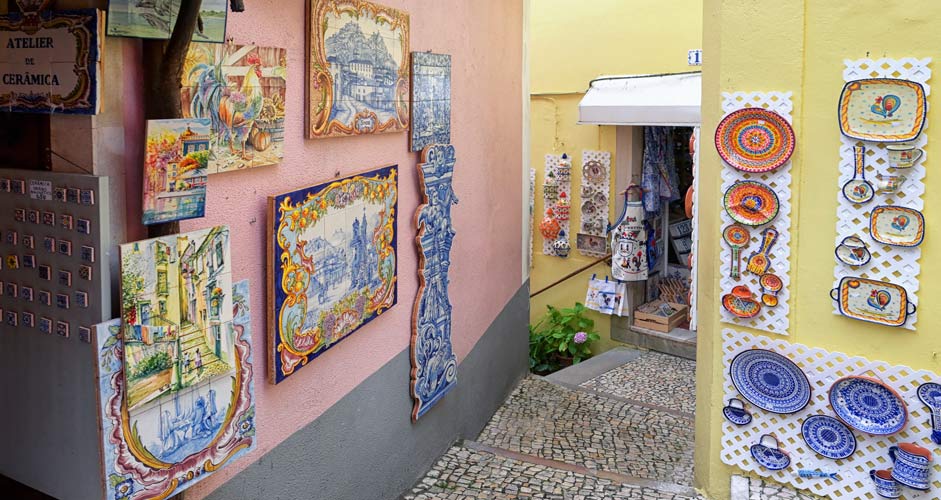
Price range
Fish meal
Steak meal
Coffee and pastry
33 cl beer
Entrance fees to palaces
€9-18
€10-20
€2-3
€2-3
€8-14
Getting around and from Lisbon to Sintra
Sintra is easily accessible from Lisbon by the CP suburban trains. The trains leave from several railway stations of Lisbon – for example Rossio, Campolide, Sete Rios, Entrecampos, Roma-Areeiro and Oriente. The journey takes approximately 40 minutes. When coming from the Lisbon airport, many of the railway stations, including Rossio, can be reached by the metro.
The Circuito do Pena 434 tourist bus is circling around in Sintra and taking travelers from the railway station to the town center, the Moorish Castle and the Palace of Pena, returning again to the railway station. During the summer season there may be queues. There are also taxis and tuktuks operating in Sintra.
Most of the things to do in Sintra, including the palaces, are located on top of mountains, and it’s not very comfortable to walk to them on the narrow roads filled with traffic. Thankfully, there are hiking trails that take visitors to the sights and palaces through the fairytale forests.
Many destinations on the coast can be accessed from Sintra by the ScottUrb buses. The buses leave either from the Portela de Sintra or the Sintra railway station.
Weather in Sintra
The climate of Sintra is mild, but the town has a microclimate that makes it cooler and more humid than the surrounding areas, thanks to the forested mountains and the altitude of over 250 meters. Sintra has been a popular summer residence town especially because of its climate, which can be noticed in the things to do in Sintra.
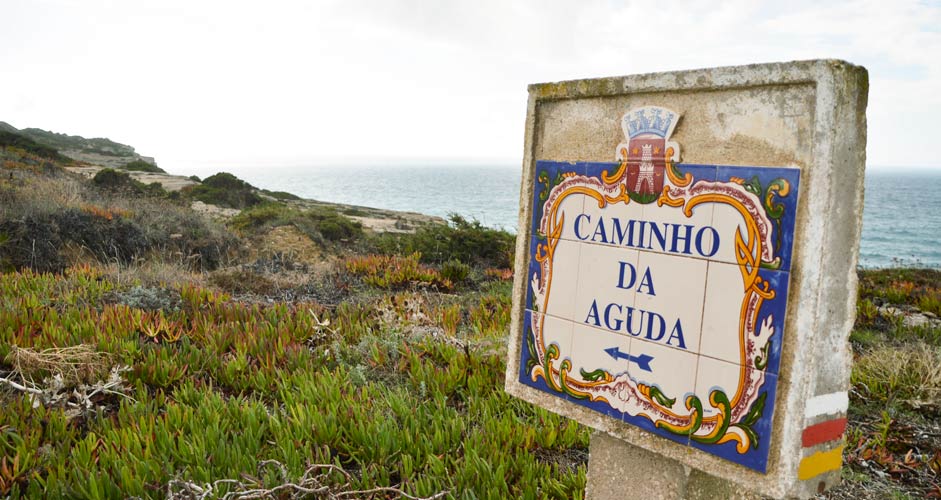
Winter: The mean temperature of the day is around 10 °C in the winter, rising up to 14 °C or so during the day. The sun is warm also in the mid-winter, but especially the northern slopes of the Sintra Mountains remain cool even during daytime. The rainiest time of the year is from November to March.
Spring: In April and May the highest temperatures reach up to 17 to 19 °C. There are some rains in the springtime and the sea fog can sometimes make the air feel cooler.
Summer: In summer, the mean temperature of the day is 19 °C. The temperatures reach some 23-24 °C and above in the afternoon. In the summer the rains are rare.
Autumn: September is still a summery month, the temperatures starting to drop in October. By November, the temperatures normally drop and the rains start.
---
Text: Johanna Maldonado
Photos: Johanna Maldonado and Adobe Stock








